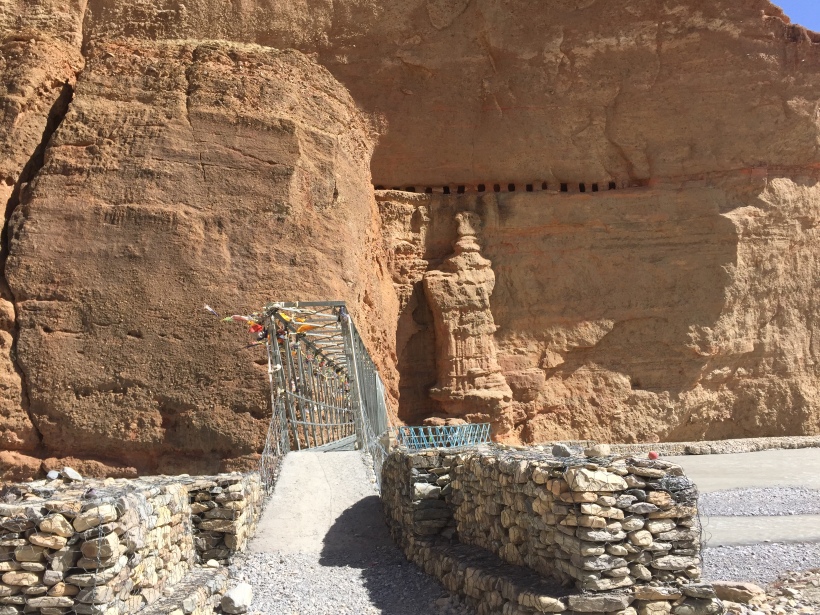
The road now climbed above Tsele heading north-west away from the excoriating wind. Neville, Jit and I set off together leaving Netra and Dabendra to finish getting the horses ready. We didn’t walk far before Nev and Jit turned off the road taking a walking track too steep and narrow for the horses. I sat and waited for the horses but was only able to ride a short distance before once more dismounting. We now joined Neville and Jit again as the track climbed very steeply clinging to the edge of the cliff face, overhung with rock in places. It was extremely hard going. It seemed like we would be climbing forever and I kept hoping that around the next bend the path would level out, but we kept climbing.

As we ascended we saw the mountains to the south rising with us. To the west, steep hills rose above us, dotted with spiky, stunted bushes. Settling on top were dark, heavy clouds that in the end brought only a brief shower.

After a couple of hours we made a welcome stop at Samar–which name means “red earth”–crossing a small stream surrounded by a grove of trees, following the stony path through a low entry passage to the Annapurna Guest House.

Here we sat in the kitchen where a wood fire burned in one stove and our host, a woman in traditional Tibetan dress, made us sweet milk tea on a gas cooker, ladling the tea continuously to dissolve the powdered milk.

In a walled yard outside a man and a young girl sat breaking rocks, which they then put into canvas feed bags. In one corner of the yard dung was spread on the ground to dry for use later as fuel.

From Samar the path led out through another gateway, down and across a bubbling, milky-blue stream, before once again climbing along the side of a cliff.

We stopped for lunch at the tiny village of Bhena. The tea house was just three rooms: a kitchen, dining room (which was also the entry) and a bedroom with a storage loft above. A small baby lay softly mewling in the bedroom and suspended above him was a plastic beachball, the only thing resembling a toy that I saw in Mustang. His older sister, who was about five, slowly inched towards us as we sat waiting for our lunch. I took out my phone and showed her how to take a “selfie” with which she was very pleased. After a few more photos that game was exhausted so I took out my small notebook and a pencil and agave it to her to draw in. Instead, she began to write ABDEF, over and over, always leaving out the C. So I wrote it correctly for her and she copied it a few times. I then handed her the pencil, indicating that she could keep it and she skipped away to show everyone.

After crossing the pass above Bhena, at 3800m, we descended to the impossibly green and beautiful village of Ghiling. As we approached, a man and woman called out and a loud discussion ensued; it was obvious we weren’t expected. Nev and I sat and waited while this was sorted out, but I had resigned myself to camping that night before Netra said “please come” and crossing a walled yard, where the garden was edged with empty Tuborg beer bottles, we entered the tea house via a passageway that led to an interior courtyard covered with a green translucent roof that bathed everything in a weird green light.

Next morning, Jit took us to the monastery that perches above the village. Back in 1992, when Mustang was first opened up to tourists, thangkas (religious paintings) and statues were stolen from the monastery. Now someone sleeps on a bed inside the entrance to guard it. A square skylight let some light into the dimly lit assembly hall where I lit a butter lamp and the monk dipped a brush into a plastic container of water and flicked it over the lamps, intoning prayers. Outside we climbed onto the roof and Jit pointed to a smaller monastery above, but said it was forbidden for women to enter, and anyway it was locked.
As we looked down on the patchwork fields of Ghiling, Jit pointed to a faint track leading away to the west between low, barren hills; this would lead us to our next destination: Tragmar.
Only later did I learn that Ghiling had lost more than 60 houses in the earthquake.
 When Michel Peissel reached this point he encountered only a simple bridge of planks of wood bolted together, impossible for his yaks to cross. There is now a steel bridge, which we walked across, but the horses had to wade across the shallow river, just as the jeeps do when the water is low enough. A road bridge is now being built and will provide vehicle access all year round.
When Michel Peissel reached this point he encountered only a simple bridge of planks of wood bolted together, impossible for his yaks to cross. There is now a steel bridge, which we walked across, but the horses had to wade across the shallow river, just as the jeeps do when the water is low enough. A road bridge is now being built and will provide vehicle access all year round.









